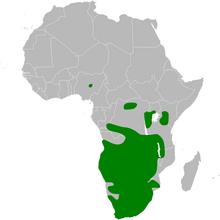Red-capped lark
| Red-capped lark | |
|---|---|

| |
| Mapungubwe, South Africa | |
| Scientific classification | |
| Domain: | Eukaryota |
| Kingdom: | Animalia |
| Phylum: | Chordata |
| Class: | Aves |
| Order: | Passeriformes |
| Family: | Alaudidae |
| Genus: | Calandrella |
| Species: | C. cinerea
|
| Binomial name | |
| Calandrella cinerea (Gmelin, JF, 1789)
| |
| Subspecies | |
|
See text | |

| |
Approximate range
| |
| Synonyms | |
| |
The red-capped lark (Calandrella cinerea) is a small passerine bird that breeds in the highlands of eastern Africa southwards from Ethiopia and Somaliland. In the south, its range stretches across the continent to Angola and south to the Cape in South Africa.
Taxonomy
The red-capped lark was formally described in 1789 by the German naturalist Johann Friedrich Gmelin in his revised and expanded edition of Carl Linnaeus's Systema Naturae. He placed it with the larks in the genus Alauda and coined the binomial name Alauda cinerea.[2][3] Gmelin based his description on "la Cendrille" from the Cape of Good Hope that had been described by the French polymath Comte de Buffon in 1778 and the "cinereous lark" that had been described by the English ornithologist John Latham in 1783.[4][5] The red-capped lark is now one of six species placed in the genus Calandrella that was introduced in 1829 by the German naturalist Johann Jakob Kaup.[6] The genus name is a diminutive of Ancient Greek kalandros, the calandra lark. The specific epithet cinerea is from Latin cinereus meaning "ash-grey" or "ash-coloured".[7]
The red-capped lark was formerly considered to be
Subspecies
Five subspecies are recognized:[6][9]
- C. c. rufipecta (Stervander et al, 2020) – Jos Plateau in Nigeria
- C. c. williamsi Clancey, 1952 – central Kenya
- C. c. saturatior Reichenow, 1904 – Uganda and western Kenya south to Angola, north-eastern Namibia, northern Botswana and Zambia
- C. c. spleniata (Strickland, 1853) – west-central Angola to west-central Namibia
- C. c. cinerea (Gmelin, 1789) – southern and central Namibia, southern Botswana, Zimbabwe and South Africa
Description
The red-capped lark is 14–15 cm (5.5–5.9 in) in length, with a typically upright stance. The colour of the streaked grey to brown upperparts is variable, with subspecies differing in hue and brightness, but this species is easily identified by its rufous cap, white underparts, and red shoulders. The short head crest is normally not noticeable except when it is raised during courtship displays.The sexes are similar in appearance. Juveniles lack the red cap and shoulders of the adults, have dark spotting on the breast, and white spots on the dark brown upperparts.[8]
The call of the red-capped lark is a tshwerp like a sparrow, and the song, given in the display flight, is a jumble of whistles and short trills. It also imitates other birds.[8]
Distribution and habitat
This is a species of short grassland including fallow agricultural areas. In eastern Africa, it is found in the highlands, normally above 1000 m, but it occurs down to sea level in suitable habitat in the cooler south of its extensive range.[8]
Behaviour and ecology
Breeding
The red-capped lark breeds all year round, but mainly from September to December. The nest is built primarily by the female in 4 to 5 days. It is an open
Food and feeding
The red-capped lark forages on bare ground or in very short grass, moving with short runs to feed on seeds and insects. It is sometimes found in flocks which can number hundreds of birds.[8]
References
- . Retrieved 13 November 2021.
- ^ Gmelin, Johann Friedrich (1789). Systema naturae per regna tria naturae : secundum classes, ordines, genera, species, cum characteribus, differentiis, synonymis, locis (in Latin). Vol. 1, Part 2 (13th ed.). Lipsiae [Leipzig]: Georg. Emanuel. Beer. p. 798.
- ^ a b Mayr, Ernst; Greenway, James C. Jr, eds. (1960). Check-List of Birds of the World. Vol. 9. Cambridge, Massachusetts: Museum of Comparative Zoology. p. 47.
- ^ Buffon, Georges-Louis Leclerc de (1778). "La Cendrille". Histoire Naturelle des Oiseaux (in French). Vol. 5. Paris: De l'Imprimerie Royale. p. 64.
- ^ Latham, John (1783). A General Synopsis of Birds. Vol. 2, Part 2. London: Printed for Leigh and Sotheby. p. 388 No. 21.
- ^ Rasmussen, Pamela, eds. (January 2023). "Nicators, Bearded Reedling, larks". IOC World Bird List Version 13.1. International Ornithologists' Union. Retrieved 16 April 2023.
- ISBN 978-1-4081-2501-4.
- ^ ISBN 978-84-87334-69-6.
- .
Sinclair, Hockey and Tarboton, SASOL Birds of Southern Africa,
External links
- Kenya Birds
- SASOL e-guide
- Species text - The Atlas of Southern African Birds

